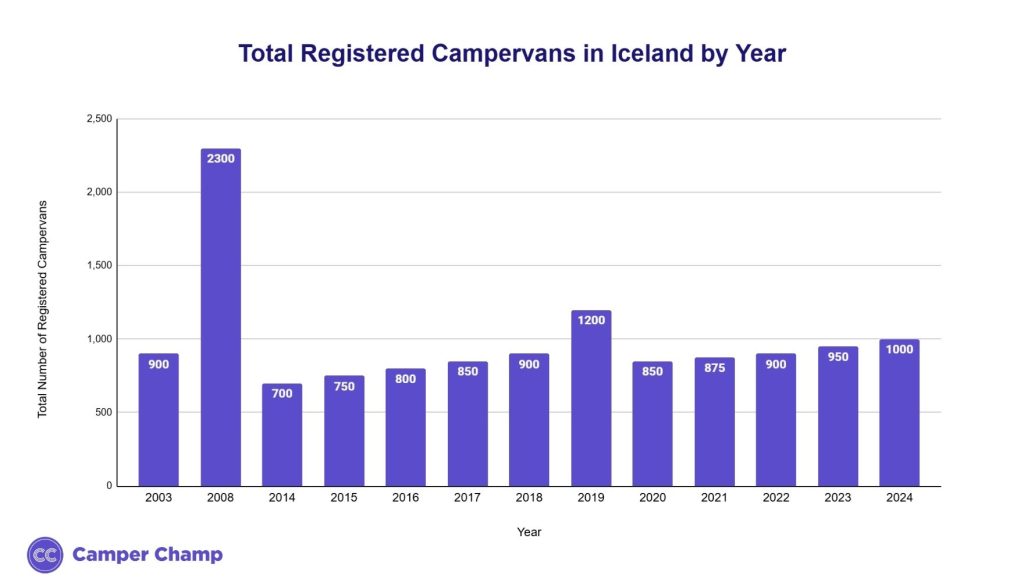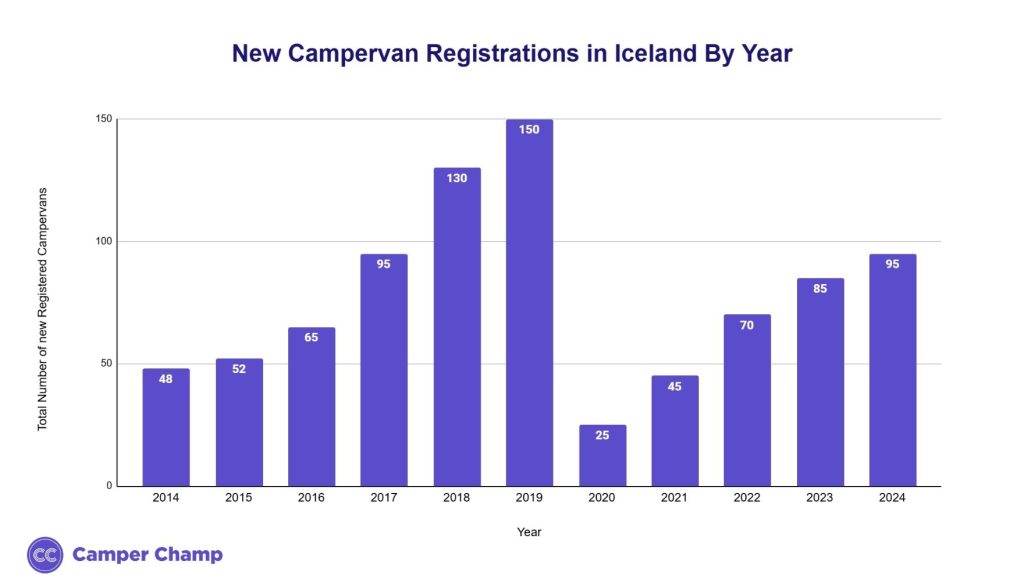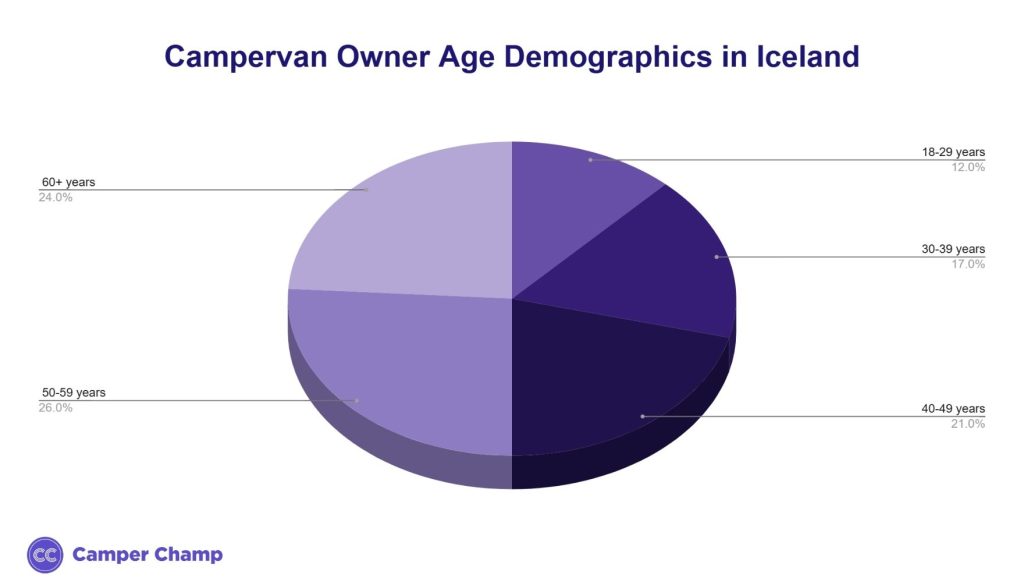Page last updated: 19 May 2025
The campervan market in Iceland has fluctuated over the last 20 years. The number of campervans peaked in 2008 and dropped sharply over the next several years. Since 2014, campervan numbers have been recovering; in 2024, there were 1,000 registered campervans in Iceland.
How many campervans are registered in Iceland?
According to 2024 data, over 1,000 campervans were registered in Iceland.
- This is a 5% increase from 2023 (950 campervans) and an 18% increase from 2020 (850 campervans); however still below the numbers right before the pandemic (1,200 in 2019).

How many new campervans are registered each year in Iceland?
The number of newly registered campervans has varied quite significantly over the recent years in Iceland. After a peak of 150 newly registered campervans in 2019, registrations have decreased to 85 in 2023.

Which regions in Iceland have the most campervan registrations?
Campervan ownership is highest around Reykjavik and Keflavik (60% of all registrations).
- The Capital Region (Reykjavík area) has the most campervans, with 35% (350+ units) of all Icelandic campervans.
- Southern Peninsula (Suðurnes) has 25% (250+ units) of all Icelandic campervans. It’s a major rental hub as it’s home to Keflavík Airport.
- South Iceland (Suðurland) has 15% (150+ units), most of which are along popular tourist routes.
- In 2024, West Iceland (Vesturland) – 10% (100+ units).
- Northeast (Norðurland Eystra) – 8% (80+ units).

Other regions:
- Westfjords (Vestfirðir) – 1% (10+ units) of total campervans.
- East Iceland (Asturland) – 3% (30+ vehicles)
- Northwest (Norðurland Vestra) – 3% (30+ vehicles)
Some regions have high ownership rates when measured per capita because of the adventure travel culture and tourism infrastructure.
Demographics of Campervan Owners in Iceland
The average Icelandic campervan owner was 49 years old in 2024.
- Age Distribution. Campervan owners are distributed across a wide span of ages:
- 24% are over 60 years old
- 26% are in their 50s
- 21% are 40-49,
- 17% are in their 30s
- and 12% between 18 and 29 years old.
- Income Levels. 70% have annual incomes over €55,000. 32% earn above €90,000.
- Family Composition. 58% have no children living at home. 42% are families with children.
- Average Travel Party. The average group size of a campervan trip is 2.2 occupants. 62% of all campervan journeys in Iceland are couple-based.

What types of campervans are most popular in Iceland?
Class B panel van conversions make up 65% of all campervans in Iceland as of 2024.
- Class B Motorhomes (Panel Van Conversions): 65% of all campervans in Iceland. Popular base vehicles are Mercedes Sprinter (38% of the Class B market), Ford Transit (32%), and Renault Master (25%).
- Class C Motorhomes (Cab-Over Style): 25% of all campervans. Adria, Hymer, and Fiat are the most common.
- 4×4 Campers: 8% of the market. Usually designed for Iceland’s F-roads and rougher terrain.
- Pop-Top Campervans: Less popular – 2% of campervans in Iceland (includes vintage as well as modern models with elevating roofs).
New vs Second-Hand
Iceland’s second-hand market is significant. 70% of annual registrations are used vehicles. 85% of these are imported from other European countries rather than bought new.
How much does it cost to own a campervan in Iceland?
Purchase Price
A brand new mid-size motorhome in Iceland costs between ISK 10-20 million (€66,000-132,000). High-end models can go up to ISK 25 million (€165,000).
On average, Icelandic campervan owners also spend ISK 500,000-1,000,000 (€3,300-6,600) per year on top of the initial purchase price.
- Vehicle tax – annual vehicle tax for a motorhome in Iceland is based on vehicle weight and emissions, usually between ISK 50,000-80,000 (€330-530) per year.
- Insurance – full coverage insurance for a campervan in Iceland is around ISK 100,000-200,000 (€660-1,320) per year for most vehicles and drivers.
- Maintenance and repairs – owners might spend around ISK 100,000 (€660) or more per year on both repairs and add-ons.
- Fuel costs – diesel, the most common fuel for campervans, can cost ISK 200,000-300,000 (€1,320-1,980) for a few thousand km.
How many campervan dealers exist in Iceland?
- Iceland had fewer than five specialised campervan dealerships in 2024, primarily in the Capital Region and the Southern Peninsula.
Iceland Travel Resources
How long do people in Iceland keep their campervans?
Icelandic campervan owners keep their vehicles for 8.5 years on average, longer than the average car ownership period of 5 years.
- Long-term owners – 45% of Icelandic campervan owners keep their vehicles for 10+ years, seeing them as long-term investments for holiday use.
- Medium-term owners – 40% of owners keep their campervans for 5-9 years, upgrading when family circumstances or financial situation change.
- Short-term owners – 15% of Icelandic campervan owners sell within 4 years of purchase (usually the vehicle was bought for a specific trip, or they didn’t like the lifestyle).
Older owners (60+) keep their campervans the longest, 10.2 years on average, while younger owners (under 40) sell after 6.3 years.
Resale Value
Well-maintained campervans in Iceland generally retain 60% of their purchase value after 5 years and 40% after 10 years.
How many campervans are produced in Iceland?
Iceland produces approximately 25 domestically converted campervans annually.
- Domestic production is limited to 3 small-scale conversion companies that collectively build fewer than 30 units per year, primarily custom conversions on imported van chassis.
- The Icelandic market relies heavily on imports, with 96% of campervans coming from abroad, 62% from Germany, and 34% from other European countries.
Campervan and Caravan Comparison in Iceland
75% of all recreational vehicles in Iceland are towable caravans. The remaining 25% are self-propelled campervans and motorhomes.
- There were 1,000 campervans and 3,000 caravans in Iceland in 2024, a 7% increase from 2019.
- Over 3,100 caravans are expected to be in use by 2025 based on steady 1-2% annual growth pre-pandemic and a 3.5% increase from 2021 to 2022.
- Iceland’s campervan-to-caravan ratio (25:75) differs from other Nordic countries such as Norway (35:65) and Finland (30:70).
Caravan vs Campervan Prices
Caravans
- New caravans cost ISK 3-7 million (€20,000-46,000) in Iceland.
- The average family caravan prices are around ISK 4-5 million (€26,000-33,000).
- Used 5-year-old caravans typically sell for ISK 2-3 million (€13,000-20,000).
Campervans
- Campervans are priced higher, with factory-built models starting at ISK 10 million (€66,000).
- Mid-range Class B campervans cost around ISK 15 million (€99,000) for new vehicles.
- Luxury models with high-end features are valued at over ISK 20 million (€132,000).
Most Popular Campervan Routes and Travel Destinations in Iceland
70% of campervan tourism in Iceland revolves around the Ring Road (Route 1). Travellers spent 10 nights on average on this route in 2024.
- The 1,300 km Ring Road has around 900,000 campervan overnight stays per year across all campgrounds and stopping points.
- South Iceland is the most visited with 40% of all campervans, followed by North East Iceland with 25% and West Iceland with 20%.
- The top 5 campervan destinations are Vík (175,000 visitors per year), Jökulsárlón (160,000), Golden Circle (240,000), Mývatn (120,000), and Snæfellsnes (100,000).
- Other popular routes are the Golden Circle (a 250 km loop from Reykjavík), which 85% of campervan tourists visit, and the Snæfellsnes Peninsula (a 90 km route), which 50% of campervan travellers visit.
Campervan Statistics by Country
- Canada Campervan Statistics
- France Campervan Statistics
- Germany Campervan Statistics
- Ireland Campervan Statistics
References
- TSI: Transport Authority of Iceland Vehicle Registration Data 2003-2024
- SI: Statistics Iceland Tourism and Accommodation Reports 2014-2023
- ITB: Icelandic Tourist Board Camping Regulations and Visitor Statistics
- ECF: European Caravan Motorhome Data and Demographics
- CIVD: Caravaning Data on Iceland Motorhome Owners
- FHI: Iceland Campervan Owners Club Survey
